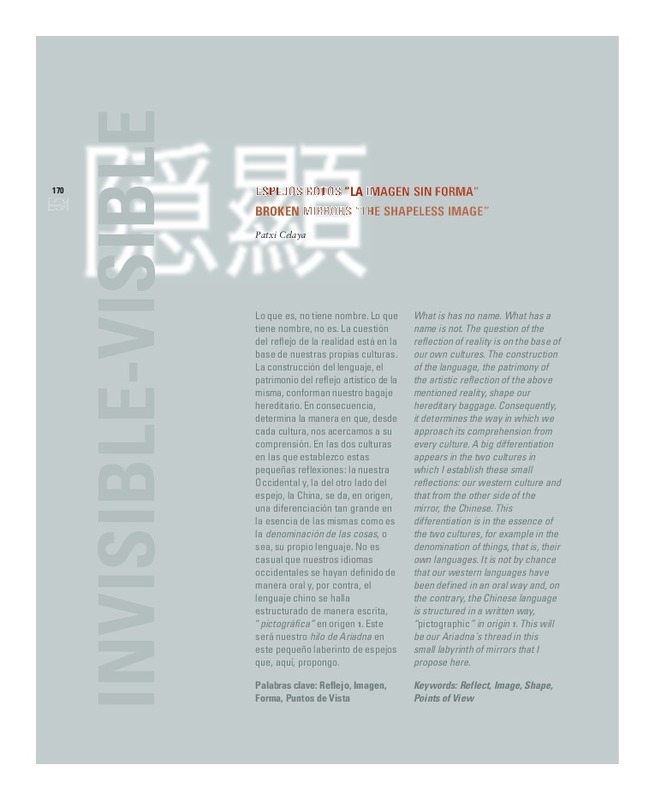JavaScript is disabled for your browser. Some features of this site may not work without it.
Buscar en RiuNet
Listar
Mi cuenta
Estadísticas
Ayuda RiuNet
Admin. UPV
ESPEJOS ROTOS "LA IMAGEN SIN FORMA"
Mostrar el registro sencillo del ítem
Ficheros en el ítem
| dc.contributor.author | Celaya, Patxi
|
es_ES |
| dc.date.accessioned | 2013-01-25T12:04:43Z | |
| dc.date.available | 2013-07-01T22:30:43Z | |
| dc.date.issued | 2012-06-30 | |
| dc.identifier.issn | 1133-6137 | |
| dc.identifier.uri | http://hdl.handle.net/10251/19052 | |
| dc.description.abstract | [EN] What is has no name. What has a name is not. The question of the reflection of reality is on the base of our own cultures. The construction of the language, the patrimony of the artistic reflection of the above mentioned reality, shape our hereditary baggage. Consequently, it determines the way in which we approach its comprehension from every culture. A big differentiation appears in the two cultures in which I establish these small reflections: our western culture and that from the other side of the mirror, the Chinese. This differentiation is in the essence of the two cultures, for example in the denomination of things, that is, their own languages. It is not by chance that our western languages have been defined in an oral way and, on the contrary, the Chinese language is structured in a written way, "pictographic" in origin. This will be our Ariadna's thread in this small labyrinth of mirrors that I propose here. | es_ES |
| dc.description.abstract | [ES] Lo que es, no tiene nombre. Lo que tiene nombre, no es. La cuestión del reflejo de la realidad está en la base de nuestras propias culturas. La construcción del lenguaje, el patrimonio del reflejo artístico de la misma, conforman nuestro bagaje hereditario. En consecuencia, determina la manera en que, desde cada cultura, nos acercamos a su comprensión. En las dos culturas en las que establezco estas pequeñas reflexiones: la nuestra Occidental y, la del otro lado del espejo, la China, se da, en origen, una diferenciación tan grande en la esencia de las mismas como es la denominación de las cosas, o sea, su propio lenguaje. No es casual que nuestros idiomas occidentales se hayan definido de manera oral y, por contra, el lenguaje chino se halla estructurado de manera escrita, "pictográfica" en origen. Este será nuestro hilo de Ariadna en este pequeño laberinto de espejos que, aquí, propongo. | es_ES |
| dc.language | Español | es_ES |
| dc.language | Inglés | |
| dc.publisher | Editorial Universitat Politècnica de València | es_ES |
| dc.relation.ispartof | EGA. Revista de Expresión Gráfica Arquitectónica | |
| dc.rights | Reserva de todos los derechos | es_ES |
| dc.subject | Reflejo | es_ES |
| dc.subject | Imagen | es_ES |
| dc.subject | Forma | es_ES |
| dc.subject | Puntos de vista | es_ES |
| dc.subject | Reflect | es_ES |
| dc.subject | Image | es_ES |
| dc.subject | Shape | es_ES |
| dc.subject | Points of view | es_ES |
| dc.title | ESPEJOS ROTOS "LA IMAGEN SIN FORMA" | es_ES |
| dc.title.alternative | BROKEN MIRRORS "THE SHAPELESS IMAGE" | es_ES |
| dc.type | Artículo | es_ES |
| dc.date.updated | 2013-01-25T10:48:59Z | |
| dc.identifier.doi | 10.4995/ega.2012.1368 | |
| dc.rights.accessRights | Abierto | es_ES |
| dc.description.bibliographicCitation | Celaya, P. (2012). ESPEJOS ROTOS "LA IMAGEN SIN FORMA". EGA. Revista de Expresión Gráfica Arquitectónica. 17(19):170-179. https://doi.org/10.4995/ega.2012.1368 | es_ES |
| dc.description.accrualMethod | SWORD | es_ES |
| dc.relation.publisherversion | https://doi.org/10.4995/ega.2012.1368 | es_ES |
| dc.description.upvformatpinicio | 170 | |
| dc.description.upvformatpfin | 179 | |
| dc.description.volume | 17 | |
| dc.description.issue | 19 | |
| dc.identifier.eissn | 2254-6103 | |
| dc.description.references | FENG Xiao Min, L'union de l'encre et du pinceau. Ed. Flammarion, París, 2003. | es_ES |
| dc.description.references | GUO Ruo Xu, Tu hua jian wen zhi. Ed. Ren Min Shu Chubansque. Beijin, 1983. | es_ES |
| dc.description.references | YU Anlan, Hua lun cong kan . Ed. Ren Min Shu Chubansque. Beijin, 1960. | es_ES |








